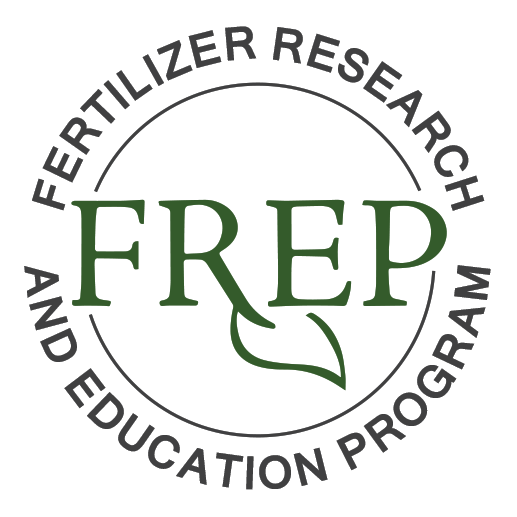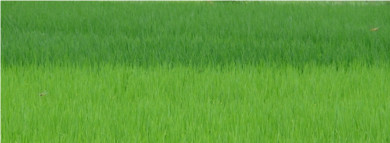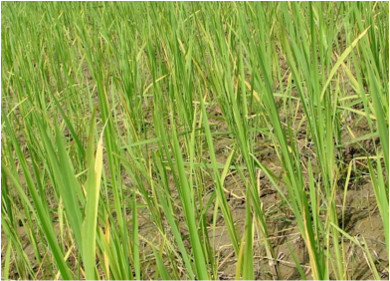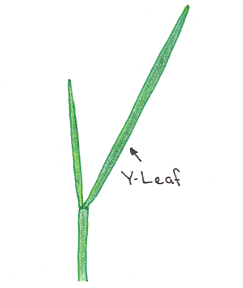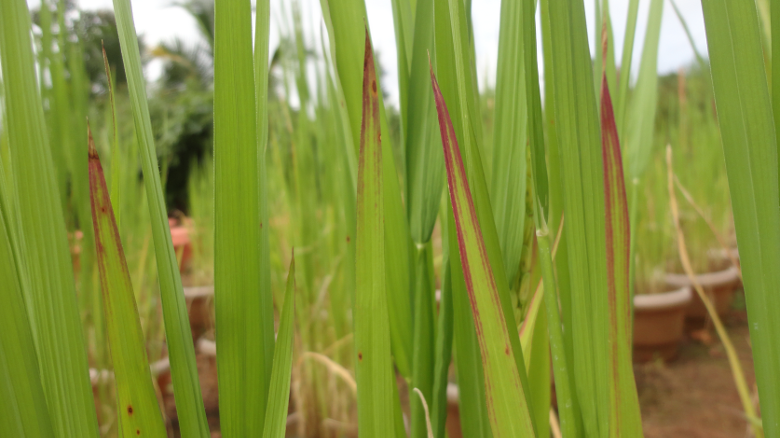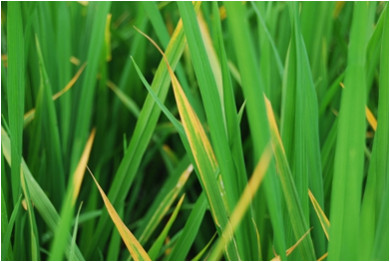| |

|

|
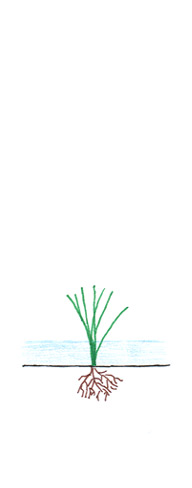
|
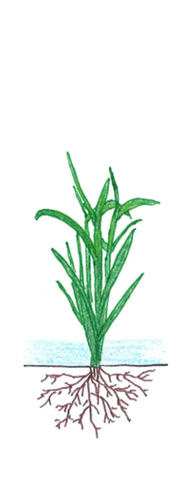
|
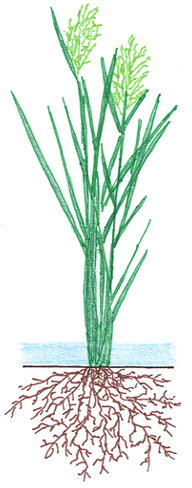
|
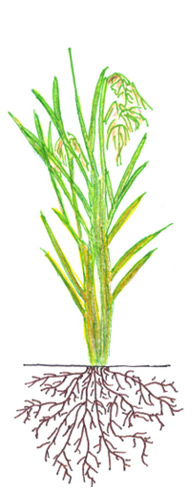
|
| Preplant | Sowing | Tillering | Panicle Initiation | Heading | Maturation |
|
Nitrogen (N)
|
Soil Test
|
|
Leaf Analysis
|
|
|
|
Topdress N
|
|
|
Nitrogen (N)
Soil Test
Leaf Analysis
Preplant N
Starter N
Topdress N
|
Close
Rice Nitrogen Nutrition
Deficiency Symptoms
Nitrogen is mobile in the plant and can be translocated from older to younger leaves. For this reason, older leaves show symptoms first. Nitrogen deficiency symptoms often appear at growth stages when N demand is large, e.g. at tillering and panicle initiation [N4].
Nitrogen deficient plants are stunted and yellowish green. Symptoms on leaves include light green color and chlorotic tips. Leaves are also narrow, short and erect. Under severe N deficiency, the leaves die. For more information, see the International Rice Research Institute's website on deficiencies and toxicities.
Pale green N deficient rice crop (bottom) compared with healthy dark green crop (top). Photo provided by the International Plant Nutrition Institute.
Nitrogen deficient rice with pale green young leaves, yellow middle leaves, and pale brown old leaves. Photo provided by the International Plant Nutrition Institute.
Close
Soil Analysis
In contrast to many row crops and vegetables, the pre-plant soil nitrate test is of little use in rice because residual soil nitrate is mostly denitrified and lost to the atmosphere when the field is flooded [N7].
No reliable soil test is available to accurately predict the N supplied by N mineralization [N23].
Close
Leaf Analysis N
The decision of whether or not to top dress can be made based on sampling leaves for N concentration or using a leaf color chart or SPAD meter to estimate leaf N concentration. If the leaf N concentration is below the critical concentration yield reductions are likely. This can often be corrected using a top-dress N application.
The most recently fully expanded leaf is used for tissue analysis. This leaf is often referred to as Y-leaf, because it forms the letter "Y" together with the stem and the youngest, still rolled leaf [N12].
The Y-leaf (adapted from [N20]).
To minimize sample variability, 50 leaves from about 30 locations within the field should be sampled at the early stages of plant development and 30-60 leaves at the later stages [N12]. Non-uniform fields are best divided into uniform areas which are sampled separately. Atypical areas in a field should be avoided (if small) or sampled separately. Samples are placed in a paper bag and dried at 140-160 °F [N12]. For more information on sampling procedure see Plant Tissue Sampling.
Leaf N concentration (and what is considered critical or adequate) declines from mid-tillering to when the flag leaf appears so it is important to know the growth stage when leaf is being evaluated. Critical and adequate N concentration in the Y leaf of rice for each stage [N12].
| Plant growth stage |
Total N (-) |
| |
Critical |
Adequate |
| Mid-tillering |
3.8 - 4.0 |
4.0 - 4.8 |
| Maximum tillering |
3.4 - 3.6 |
3.6 - 4.2 |
| Panicle initiation |
3.0 - 3.2 |
3.2 - 3.6 |
| Flag leaf |
2.6 - 2.8 |
2.8 - 3.2 |
The N status of rice plants is reflected in the leaf color, with a light green color indicating low N availability as opposed to a dark green color. Mutters [N17] developed and calibrated a leaf color chart for California conditions. Even though leaf greenness differed between varieties, Y-leaf N content at panicle initiation across a number of varieties could explain 86% of the variability in leaf color [N17]. Samples taken from 86 fields located in 8 counties showed a close relationship between leaf N concentration and leaf color chart number (See Table). Relationship between leaf color chart and total N (%) in the Y-leaf of rice [N17].
| Leaf N(%) |
Panel number |
| |
1 |
2 |
3 |
4 |
5 |
6 |
7 |
8 |
| Panicle initiation |
1.4 |
1.9 |
2.3 |
2.7 |
3.1 |
3.6 |
4.0 |
4.4 |
Another way to determine the N status of rice plants is to measure leaf greenness using a hand-held device, such as the SPAD Chlorophyll Meter. The chlorophyll meter measures the amount of light absorbed by chlorophyll, the green pigments in leaves responsible for photosynthesis. As is the case with the leaf color chart, the SPAD Chlorophyll Meter readings are correlated with the leaf N content and can be used for real-time N management decisions [N24]. The relationship between chlorophyll meter reading and total leaf N concentration depends on rice variety (see Table).
The placement of the chlorophyll meter on the leaf surface must be consistent. The table values are based on readings 6 inches from the tip of the 'Y' leaf. Placing the meter on the leaf mid-rib or on a lesion will produce unreliable results (Mutters, personal communication). Relationship between SPAD Chlorophyll Meter reading and total N (%) in the Y-leaf of rice at panicle initiation stage [N23].
| Variety |
SPAD reading |
| |
25 |
30 |
35 |
40 |
45 |
| Akita, Koshi |
1.8 |
2.3 |
2.8 |
3.3 |
3.7 |
| S-102 |
2.3 |
2.8 |
3.3 |
3.8 |
4.3 |
| Calhikari, Calmati, L-204, L-205, M-202, M-204, M-205 |
2.2 - 2.6 |
2.9 - 3.2 |
3.6 - 3.8 |
4.2 - 4.6 |
4.8 - 5.3 |
At the panicle initiation stage, the adequate leaf N content is 3.2-3.6% [N12].
Close
Preplant N
The optimal fertilization program depends on water management. With continuous flooding, N is generally applied pre-plant [N23]. When fields are drained early in the season for prolonged periods, a split application may be considered (See below).
Split applications with part of the N applied pre-flooding and the rest as a topdressing generally do not result in increased yields compared to a single pre-flooding application [N1, N15, N22].
Pre-plant N applications to rice, typically applied as aqua ammonia, do not increase the risk of nitrate leaching and high N use efficiencies can be achieved [N9, N11]. When the field is flooded soon after the application of the fertilizer, ammonium is not oxidized to nitrate. Ammonium, being a positively charged ion, does not leach as easily as nitrate. In addition, rice is grown in fields with high clay content or an impermeable layer, that considerably reduce downward movement of water and dissolved nutrients. In fact, Liang and coworkers [N6] found low nitrate concentrations below the rooting zone, suggesting that leaching of nitrate is not of concern. Furthermore, applying all N pre-plant is simple and requires less labor than other programs.
However, high pre-plant application rates result in high ammonium concentrations early in the season when plant uptake is still small, which may result in increased risk of lodging, disease and weed pressure. The possibilities for in-season adjustments are also more limited when rice N fertilizer needs are different than expected [N23].
When the field is drained early in the season (first 40 days), the N applications are best split and part of the N topdressed [N23]. Short drain periods for establishment (i.e. Leather's method) or weed control are normally not considered prolonged. In general, a prolonged period can be considered as longer than a week with water off the field. An example of a prolonged period is when fields are drained and allowed to dry to the point where the soil can support a vehicle. During a prolonged drain period, a considerable proportion of the ammonium still present from the pre-plant or starter application may be nitrified to nitrate. The nitrate not taken up by the rice plants until the field is flooded again is likely lost due to denitrification. In a survey of 22 fields, Linquist and coworkers [N11] found that on average 1.8 lbs/acre of nitrate-N were produced during each day a field was drained. A 10- to 11-day drain period, 1-2 weeks after planting, resulted in the accumulation of up to 30 lbs/acre nitrate-N in the top 6 inches of the soil profile [N11]. N uptake data suggested that about 60% of the nitrate was lost when the field was flooded again. Therefore, extended drain periods should be avoided, particularly in the first 40 days when fertilizer N is still in the soil.
A total N application rate of 150 lbs/acre is considered average [N21]. Maximum yields of up to 12,000 lbs/acre were obtained with application rates ranging from 140 to 190 lbs/acre [N8, N9, N10]. Due to site-specific factors, such as N mineralization potential of the soil, and yield expectations, the required fertilizer N may vary by location. Specialty varieties may also have lower N requirements due to lower yield potential and a higher risk of lodging. Contact your local farm advisor for more information.
Rice straw incorporation can increase the amount of N supplied by the mineralization of soil organic matter over the years, so that the N fertilization recommendation may be reduced by 10-20 lbs/acre when straw incorporation and winter flooding are consistently practiced after harvest [N5, N7].
Due to variation, a good approach to an application rate for a particular field is to establish strips with different application rates down the length of the field using aqua rig. The rates applied in the strips should be 25 lbs/acre lower and higher than the rate typically applied to the field. The strips can then be harvested individually using a combine with a yield monitor and based on the differences in yield between the strips one can determine if the standard rate needs to be adjusted up or down. The strips should be located in representative parts of the field and this should be done over several years to get the most accurate rate possible.
Aqua-ammonia, which is the main N source in California rice systems, is chiseled to a depth of 3-4 inches where it is protected from ammonia volatilization and denitrification losses when the field is flooded [N1, N2, N3, N13, N14].
If urea is applied pre-plant the hydrolysis to ammonium locally increases soil pH, which can lead to high losses due to ammonia volatilization when the urea is applied to the soil surface. Therefore urea should be incorporated [N23].
In addition, incorporation of urea and ammonium fertilizers prevents nitrification in the aerobic top layer of the soil. When the nitrate produced moves to anaerobic zones, it is lost through denitrification [N3, N13].
Only urea or ammonium fertilizers are used in rice, as nitrate would be lost through denitrification under the anaerobic conditions found in flooded soil. Aqua-ammonia is the main N source in California rice systems. Of the total N rate, as much of the fertilizer N as possible should be applied as aqua-ammonia. The remainder of the N rate will be applied in the starter blend. The amount of N in the starter blend will depend on the P requirement and the source of P used (see Phosphorus below). However, a number of fertilizers are available, with the most important ones listed in the table. Common N fertilizers used in rice [N4].
| Fertilizer |
Formula |
N content |
| Aqua ammonia |
NH4OH |
20% |
| Ammonium chloride |
NH4CI |
28% |
| Ammonium sulfate |
(NH4)2SO4 |
21% |
| Ammonium bicarbonate |
NH4HCO3 |
17% |
| Urea |
CO(NH2)2 |
46% |
| Monoammonium phosphate (MAP) |
NH4H2PO4 |
11% |
| Diammonium phosphate (DAP) |
(NH4)2HPO4 |
18 - 21% |
| Urea phosphate |
CO(NH2)2 + H3PO4 |
18% |
Aqua ammonia is a popular fertilizer for pre-plant applications [N23]. Urea dissolves quickly and is converted to ammonium within a few days [N23].
The efficiency of the fertilizers listed in the table is similar. Some studies, however, reported that ammonium sulfate tended to be more effective than other N fertilizers [N1, N15].
Pre-plant N fertilizers should be applied as close to flooding as possible to prevent nitrification and subsequent denitrification losses.
Close
Starter Nitrogen
The recovery of pre-plant aqua ammonia has been found to be higher than that of starter N in continuously flooded fields [N9]. Even though starter N promoted early growth, the grain yields were higher when all N was applied pre-plant as aqua ammonia. In this study, aqua N was injected to a depth of 3-4 inches, while the starter N was applied to the soil surface. Based on these results and the fact that starter N is more expensive than aqua ammonia, Linquist and coworkers [N9] concluded that surface starter N applications are not justified [N9]. In addition, starter N applied to the soil surface is prone to being lost when the field is drained during the early season [N11].
When a P application is necessary, granular or liquid blends with the lowest possible N content should be used. The N should be considered as part of the total N rate and subtracted from the pre-plant application rate. The N in the starter, however, may increase P uptake. Starter fertilizer should be incorporated or lightly harrowed in. If algae are a problem this starter blend can be applied up to 30 days after planting without affecting yields (See Phosphorus).
Close
Topdress N
It is generally not recommended planning a for a mid-season topdress N application as research has shown it is most efficient to apply all the N at preplant. However, midseason applications are beneficial when the field is drained for a prolonged period during the early season (see Pre-plant N) or when a midseason leaf analysis indicates that N supply is insufficient.
Ideally, no more than 30 lbs/acre should be applied at midseason. At application rates exceeding 60 lbs/acre, the efficiency of the N fertilizer is greatly reduced [N18]. Contact your local farm advisor for more information.
Midseason applications should be based on leaf color charts or chlorophyll meter readings (see Leaf Analysis).
Since fields are usually flooded during this period, fertilizer is most commonly applied by aircraft.
A number of ammonium fertilizers and urea can be used (see Pre-Plant N). Ammonium sulfate is popular for topdressing by aerial application due to its lower N content and greater mass than urea, which helps ensure a more even application [N23]. However research has shown that both ammonium sulfate and urea are equally efficient as long as sulfur is not deficient [N19].
Midseason N applications should be made before the panicle initiation stage, roughly 50-55 days after sowing. At the panicle initiation stage, a light green band can be noticed above the top node [N16, N18].
When fields are drained, N fertilizer is best applied just before flooding the field to prevent nitrification.
|
| Preplant | Sowing | Tillering | Panicle Initiation | Heading | Maturation |
|
Phosphorus (P2O5)
|
Soil Test
|
|
Leaf Analysis
|
|
|
Preplant / Starter P
|
Topdress P
|
|
|
Phosphorus (P2O5)
Soil Test
Leaf Analysis
Preplant / Starter P
Topdress P
|
Close
Rice Phosphorus Nutrition
Deficiency Symptoms
Phosphorus is mobile in the plant and can be translocated from older to younger leaves. For this reason, symptoms first appear on older leaves. Phosphorus deficient plants are stunted and tillering is reduced. Leaves are dark green, narrow, short and very erect. Leaves may also develop red and purple colors. Stems of N deficient plants are thin and spindly [P1]. For more information, see the International Rice Research Institute's website on deficiencies and toxicities.
Purple discoloration of a P deficient leaf. Photo provided by the International Plant Nutrition Institute.
Occurrence
Phosphorus deficiency is not very common in California rice fields. Recent P fertilization trials carried out at a large number of sites in the Sacramento Valley found a significant response to P fertilizer at less than 10% of the sites [P3, P13]. For more information about soil P availability in your area, contact your local farm advisor.
Close
Soil Analysis
Soil Sampling
The root system of rice in flooded systems is shallow. Between 70 and 90% of the roots have been found to be in the top 4 inches of the soil profile [P8]. For this reason, samples for soil tests are generally taken from the plow-layer (top 6 inches of the profile) [P14] (see Soil Test Sampling for sampling instructions).
Plant-available P is determined by extracting the soil samples with sodium bicarbonate, which is also referred to as the Olsen-P method [P3, P14].
Interpretation of Results
Trials at 64 sites in the Sacramento Valley indicated that an Olsen-P value of 6-9 mg/kg (= 6-9 ppm) in the top six inches of the profile is a suitable critical value [P3]. However, the relationship between soil test and yield response is not very close. Combining soil tests with a P budget or tissue tests is therefore recommended to identify sites where a yield response to P fertilization may be achieved [P3, P14]. Contact your local farm advisor for more information.
P is more available in flooded soils. If rice is grown in rotation with other crops, the soil test may indicate a sufficient P availability for rice, while other crops may suffer P deficiency [P14].
Close
Leaf Analysis
The most recently fully expanded leaf is used for tissue analysis. This leaf is often referred to as Y-leaf, because it forms the letter "Y" together with the stem and the youngest, still rolled leaf [P6].
The Y-leaf (adapted from [P12]).
To minimize sample variability, 50 leaves from about 30 locations within the field should be sampled at the early stages of plant development and 30-60 leaves at the later stages [P6]. Non-uniform fields are best divided into uniform areas which are sampled separately. Atypical areas in a field should be avoided (if small) or sampled separately. Samples are placed in a paper bag and dried at 140-160 °F [P6]. For more information on sampling procedure see Plant Tissue Sampling.
Earlier work suggested a critical P value of 1,000 ppm acetic acid extractable P for early sampling and 800 ppm for samples taken between panicle initiation and flag leaf appearance (See Table) [P6].
A recent study carried out by Linquist and Ruark [P3] at more than 60 sites in the Sacramento Valley suggested that a total P concentration of 0.2% (2,000 ppm) or less in Y-leaves sampled 35 days after seeding should be considered deficient. Critical and adequate concentration of acetic acid extractable P in the Y-leaf of rice [P6].
| Plant growth stage |
Acetic acid extractable phosphorus (ppm PO4-P) |
| |
Critical |
Adequate |
| Mid- to maximum tillering |
1,000 |
1,000 - 1,800 |
| Panicle initiation to flag leaf |
800 |
800 - 1,800 |
The results of leaf analyses may be known too late to correct P deficiency in the same season. However, leaf analyses provide valuable information for managing P in the following season [P3].
Close
Preplant / Starter P
Phosphorus fertilization should be based on soil test results and, where available, with historical nutrient budgets (see Soil Test). The Phosphorus Fertilizer Budget and Application online calculator provides guidelines on the need for P applications based on yield levels and soil P tests.
When the soil test level exceeds 15 ppm Olsen-P, the plants are unlikely to respond to P fertilizer [P3]. Therefore, P fertilization is not needed.
With a soil P test level between 6 and 15 ppm, rice may benefit from P fertilization [P3]. In this case, a maintenance application is recommended. This is the amount of P removed with the grains and the straw, if harvested. Rice grains contain between 0.15 and 0.25% P [P2]. Therefore, with a grain yield of 8500 lbs/acre, 30-50 lbs P2O5/acre (13-21 lbs P/acre) are removed from the field. The P concentration in the straw generally averages 0.08% [P2, P7]. Assuming a harvest index of 0.5 [P3] and removal of half the straw, approximatley 8 lbs P2O5/acre are removed from the field with the straw.
When the Olsen-P concentration is below the critical level of 6 ppm, P may be limiting rice growth [P3]. In this case, higher rates are advisable to build up soil P, especially when leaf analyses are low as well [P3]. To correct P deficiency, the application rate can be increased to 60 lbs P2O5/acre [P14]. Contact your local farm advisor for more information.
Incorporating or harrowing in P has several advantages compared to leaving it on the surface: (i) The P is in close proximity to the young rice roots and therefore easily accessible, (ii) growth of algae, especially the so-called "black" algae (Nostoc spongiaeforme), and weeds is reduced [P5, P9, P11, P14], (iii) P losses with drainage water are reduced when the field is drained after planting [P14], and (iv) when ammonium phosphate is the source of P, incorporation reduces nitrification (microbial transformation of the ammonium to nitrate) and subsequent loss of the N (see Pre-Plant N).
The most commonly used materials are ammonium phosphates. However, any water-soluble P fertilizer can be used to correct P deficiency in rice [P14] (see Table). Phosphorus fertilizers for rice [P1].
| Fertilizer |
P2O5 content |
| Single superphosphate |
16 - 21% |
| Triple superphosphate |
41 - 50% |
| Monoammonium phosphate (MAP) |
51% |
| Diammonium phosphate (DAP) |
46 - 53% |
| Urea phosphate |
46% |
Starter fertilizers are often granular or liquid blends containing N, P and K. Blends with the lowest possible N content should be used.
The application of starter blends containing N, P, and K may in some cases enhance early season vigor. However, this does not always result in higher yields [P13]. Given the small benefits of starter P and N (see Starter N), applying a starter blend may not be beneficial enough to justify the costs.
Phosphorus is generally supplied in a single application before planting [P14]. However, when the field is not P deficient, P fertilizer can be applied anytime [P4]. In P deficient fields, P applications made before 30 days after planting are most effective [P4]. When algae growth is a problem, the P application can be delayed until after the leaves have emerged from the water surface (usually after 21 days). See Topdress P for more information.
Close
Topdress Phosphorus
Phosphorus can be water-applied as late as 30 days after seeding even to fields with a low P availability. In order to reduce losses and avoid water quality issues, the field should not be drained within two weeks after fertilization [P4, P5]. Delaying P fertilizer application until rice seedlings have emerged from the water instead of a surface starter application may be an alternative algae management method for some growers [P5, P10, P11].
When blends are used, those with the lowest possible N content should be used. The N should be considered as part of the total N rate and subtracted from the pre-plant application rate.
|
| Preplant | Sowing | Tillering | Panicle Initiation | Heading | Maturation |
|
Potassium (K2O)
|
Soil Test
|
|
Leaf Analysis
|
|
|
Preplant / Starter K
|
Topdress K
|
|
|
Potassium (K2O)
Soil Test
Leaf Analysis
Preplant / Starter K
Topdress K
|
Close
Rice Potassium Nutrition
Deficiency symptoms are first visible on older leaves because K is, like N, P and Mg, mobile in the plant and can be translocated from older to younger leaves. Potassium deficient plants are stunted and dark green. The tips and margins of older leaves turn yellowish brown, while younger leaves are short, droopy and dark green. Under severe K deficiency, dark brown necrotic spots appear, first on the tips, later spreading over the entire leaf blade. Under severe K deficiency, the leaves die [K2]. For more information, see the International Rice Research Institute's website on deficiencies and toxicities.
Potassium deficiency symptoms include yellowish brown leaf margins on the tip of older leaves. Photo provided by the International Plant Nutrition Institute.
An adequate K supply decreases the severity of aggregate sheath spot disease [K8, K14].
Potassium deficiency is not common in rice fields in California. Soils that may be affected are red alluvial terrace soils on the eastern side of the Sacramento Valley with a low cation exchange capacity and some light-textured soils along basin rims [K13, K15]. For more information about soil K availability in your area, contact your local farm advisor.
In addition, when straw is removed from the field, the soil may become depleted in K over the years, as the K concentration in straw is approximately five times higher than in the grain (see Pre-Plant K Application Rate).
Close
Soil Analysis
The root system of rice in flooded system is shallow. Between 70 and 90% of the roots have been found to be in the top 4 inches of the soil profile [K10]. For this reason, samples for soil tests are generally taken from the plow-layer (top 6 inches of the profile) [K15] (see Soil Test Sampling for sampling instructions).
The ammonium acetate extraction method has been found to be an excellent predictor of soil K deficiency and rice grain yield [K14] and could accurately predict crop responses to various levels of K addition when pre-fertilization available soil K concentrations were below 120 ppm (Linquist, personal communication).
Close
Leaf Analysis
The most recently fully expanded leaf is used for tissue analysis. This leaf is often referred to as Y-leaf, because it forms the letter "Y" together with the stem and the youngest, still rolled leaf [K5].
The Y-leaf (adapted from [K12]).
To minimize sample variability, 50 leaves from about 30 locations within the field should be sampled at the early stages of plant development and 30-60 leaves at the later stages [K5]. Non-uniform fields are best divided into uniform areas which are sampled separately. Atypical areas in a field should be avoided (if small) or sampled separately. Samples are placed in a paper bag and dried at 140-160 °F [K5]. For more information on sampling procedure see Plant Tissue Sampling.
Critical and adequate concentration of extractable K in the Y-leaf of rice [K5].
| Plant growth stage |
Extractable Potassium (%) |
| |
Critical |
Adequate |
| Mid-tillering |
1.4 |
1.4 - 2.8 |
| Maximum tillering |
1.2 |
1.2 - 2.4 |
| Panicle initiation |
1.0 |
1.2 - 2.4 |
| Flag leaf |
1.0 |
1.2 - 2.2 |
At flowering, leaf K levels below 1.2% have been found to be inadequate for high yielding rice [K2].
Close
Preplant / Starter K
Potassium applications should be made based on soil test results. With soil test values between 60 and 120 ppm, the K removed with the grain and the straw, if harvested, should be replaced [K6].
Rice grains most commonly contain between 0.25 and 0.33% K [K3]. Therefore, with a grain yield of 8500 lbs/acre, 25-35 lbs K2O/acre (21-28 lbs K/acre) are removed from the field.
The K concentration in the straw generally ranges from 1.3-2.0% [K3, K9]. Assuming a harvest index of 0.5 [K7] and removal of half of the straw, 65-100 lbs K2O/acre (55-85 lbs K/acre) are removed from the field when half the straw is harvested. However, when the rice straw is left in the field over winter, a large proportion of the K in the straw (up to 80%) may be returned to the soil with winter rains, considerably reducing the K removed from the field with the straw in spring [K1].
When soil test values are below 60 ppm, the application rate may be increased, especially when leaf analyses also suggest inadequate K supply. With soil test values above 100 ppm, K fertilization is unlikely to have an effect on yield. Contact your local farm advisor for more information.
Pre-plant K should be incorporated into the soil because of the limited mobility of K in soil [K15]. Incorporation is even more important when blends containing N and P are used (see Pre-plant N and P).
The most common K fertilizers used are potassium chloride and potassium sulfate (see Table). As both are readily available, they generally do not differ in their effectiveness. At excessive application rates, however, rice plants may be damaged by the chloride contained in potassium chloride [K15]. Potassium fertilizers for rice [K2].
| Fertilizer |
Formula |
K2O content |
| Potassium chloride |
KCI |
60% |
| Potassium sufate |
K2SO4 |
50% |
The application of starter blends containing N, P, and K may in some cases enhance early season vigor. However, this does not always result in higher yields [K13]. The same study found that omitting K from the blend had little effect on rice yield [K13]. Given the small benefits of starter P and N (see Starter N and P), applying a starter blend may not be beneficial enough to justify the costs. Blends with a low N content should be used. Starter fertilizer should be incorporated or lightly harrowed in.
If K fertilizer is needed, pre-plant applications are the most effective. Potassium in the starter blend can also be applied up to 30 days after planting to help avoid algae problems associated with P in the blend (See Phosphorous). Topdressing at mid-tillering is also possible; however, applications at this time are not as effective as pre-plant applications. Therefore, if soil K values are considered deficient (<60 ppm), K fertilizer should be applied before planting. Potassium applications after panicle initiation may not affect yield but can reduce symptoms and help increase overall plant vigor [K4].
Close
Topdress Potassium
Potassium uptake by rice plants is low during the first month after planting [K11]. For this reason, when K is not applied pre-plant, it can still be applied during tillering. However, pre-plant applications have been found to be more effective than topdressing at tillering [K15]. Potassium in the starter blend can also be applied up to 30 days after planting to help avoid algae problems associated with P in the blend (See Phosphorous). Potassium applications after tillering are least effective.
For more information see Pre-plant K.
|




